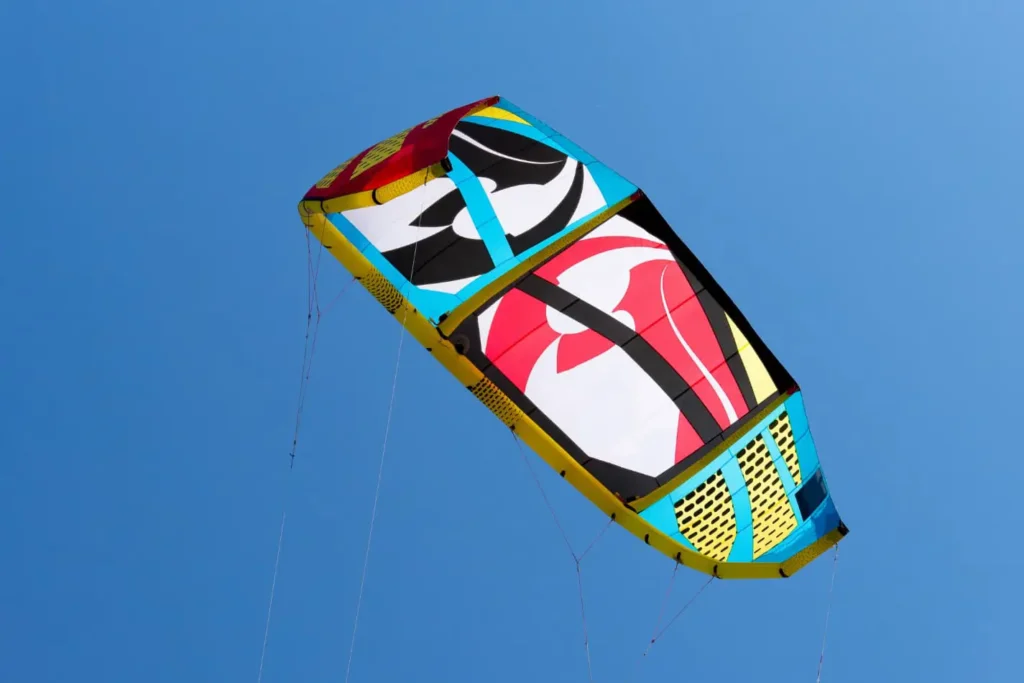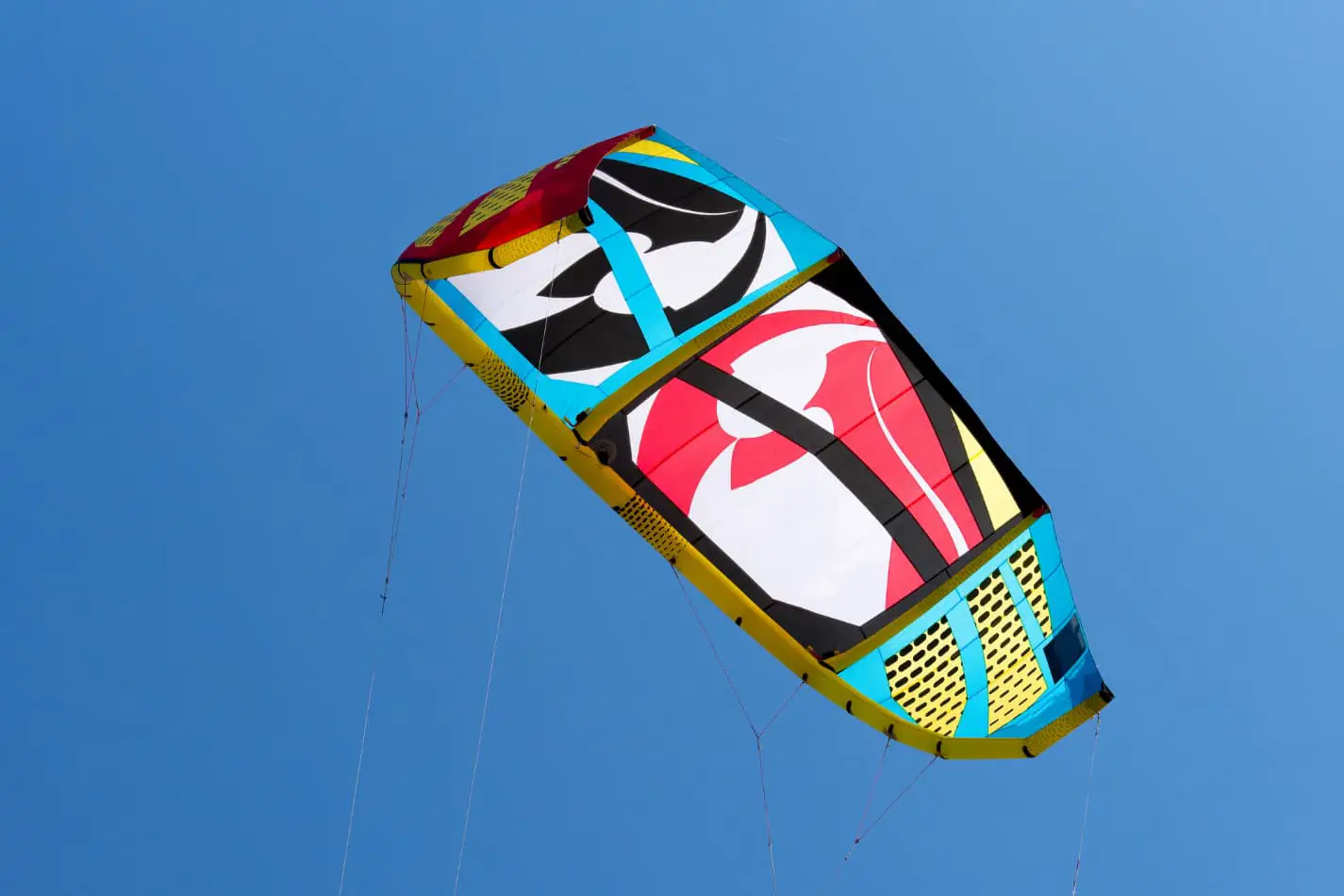Kiteboarding kites can be expensive. A good one can cost like $1000 and some even more. So, as a concerned consumer, you’re probably wondering how long do kiteboard kites last before you have to go out and buy another one.
The lifespan of a kite is determined by its use and the conditions in which it is used. A kite typically lasts 5-7 years before needing to be replaced. If you use your kiteboard more than 50 times yearly, I recommend replacing it every three years.
Kites are the most delicate part of a kiteboard, but they are also the driving force that keeps it moving. The lifespan of a kite can be increased if the user follows the right guidelines.
Please keep reading to learn how to make your kiteboard kite last longer!

Reasons Your Kiteboard Kite Doesn’t Last Long
In kiteboarding, kites like this Progressive Flow are the equipment that moves the board. When you ride on a kiteboard, the kite gets exposed to intense pressure.
This is why the materials tend to be strong enough to withstand those conditions.
The kite must be as light as possible to capture the wind while being durable enough to avoid being ripped by it.
We regularly expose our kites to a variety of adverse conditions. The frequency of exposure is what causes them to deteriorate.
The longer you expose your kite to these elements, the worse it will become over time.
Let’s talk about some of them to understand how your kite slowly deteriorates with use.
Sunlight
Just like we use sunscreen to protect ourselves from UV rays, modern kites also have UV protection.
However, like sunscreens, the protection on the kites doesn’t last forever. These days manufacturers use polyester to make kites.
Because they have good UV-resisting properties. UV rays break the bonds of polymer chains which causes the material to weaken.
Older kites are more prone to tear, as the material doesn’t stay as strong as before. Also, leaving the kite in heat will cause your kite valves to delaminate and ultimately leak air.
Sand
Exposure to sand can cause the fabric of your kite to ruin faster. Also, getting sand in the bladder while pumping your kite can damage it, leaving tiny pinholes.
Repairing leaks from sand is more challenging than you might think. The holes are small and need a lot of attention to be found.
Leaving your bars on the sand for too long can also damage them. The weaving can open up if the bar lines are under tension, allowing sand to get in.
The sand could shrink your pipes or even damage them, especially if you tighten pigtails that have sand in them.
Also, check your quick release so that it does not have sand to interrupt performance.
Wind and Salt Water
People often leave their kites on the open beach when resting, which exposes them to the wind. Yes, wind can also weaken your kite.
The trailing edge flutters in the wind, causing the kite’s canopy to weaken.
Lastly, you’re exposing your kite to seawater as well. Letting the seawater dry up will leave sharp salt crystals, weakening the kite over time.
Likewise, salt will also get into the valves, leaving tiny pinholes.
How To Make Your Kite Last Longer?
The most important part of your kit is the kite. Kiteboarding requires a lot of attention to its gears. So, it would be best if you looked after your kite.
The last thing you want is your kite falling out of the sky or missing a session because of a leak.
No worries, I’ve got you covered! Below is a list of tips on how to make your kite last longer.
The 15 Minute Rule
Do not leave your kite out in the sun for more than 15 minutes. The sun deteriorates the outer protective coating, the shiny layer outside of the kite.
You want the kite to be crispy, and you want to see that glossy coating. Faded kites are not good kites to buy, mainly second-hand.
This layer prevents water from getting in. If water gets into the kite, water penetrates the kite and makes it heavier.
It’s not so nice to fly when water gets into the kite, but also the sun makes it more brittle, and when you crash, the kite will reap a lot easier.
Moreover, the heat will melt the glue that holds the valve and the bladder together. You want your kite to be crispy and have that shiny coating on it at the end of every season before you store it or sell it.
Thus, don’t let it soak in the sun.
Go For The Black Kites
The color of the fabric of your kite also plays a role in longevity. Deeper-colored fabrics are more UV resistant than light colors, which is why most beach kites are deeper and richer in color.
However, pitch-black has the highest UV resistance of all colors and can be worn for an extended period.
This is why I go for the black kite when buying one.
Get A Sandbag
Protecting your kite is essential. So, get a sandbag for your kite when you put other things on it.
Do not use stones or sand to get that extra weight you need on a windy day. Sands will rub against the fabric and make its quality worse.
Putting stones on your beautiful kite also sounds disrespectful, so don’t. Stones will get your kite pinholes, which can get bigger over time. A sandbag looks way better and cooler.
Use Fresh Water To Clean Your Kite
After a good kiteboarding session, cleaning your whole kiteboard kit is essential.
Especially since you don’t want any sand to remain on your board when storing it, the remaining sand will rub against your kite’s material and its stitching, weakening it.
This is why you use fresh water to clean your kite after use. If you use salt water, salt crystals will accumulate in all the places of the kite, and you do not want that.
Pack Your Gear Up
You would want to pack your kiteboarding gear up and not just let it sit in the open, exposing it to many factors. You clean it up and pack up as soon as you are done.
Letting it sit around will weaken it due to exposure to fast wind and hot sun. It might look like there is no harm in it, but you will notice your kite becoming thin over time.
What to Look for In A Kite?
A good kite is essential for kiteboarding. Without it, the sport itself wouldn’t exist, so there is special importance to this particular gear. A good kite needs to be lightweight, flexible, and durable.
Kites can be ripped apart by waves. This is why the strength of the fabric is so important in preventing crashes.
That’s why a canopy-style kite with strong seams is the way to go. Some of the most durable kiteboard kites I can recommend are:
Conclusion
Kiteboarding is a fun sport to participate in. It also allows you to spend some quality time at the beach and explore it in the best possible way.
However, it would be best if you took extra care when buying a good kite, as that will be the first determining factor of your kite’s longevity.
Now that you made it to the end of the article, I hope you now understand how long do kiteboard kites last. Thanks for stopping by.

